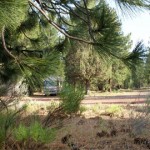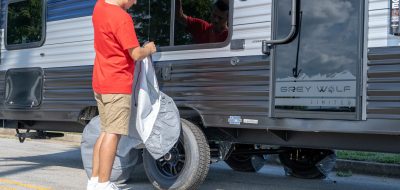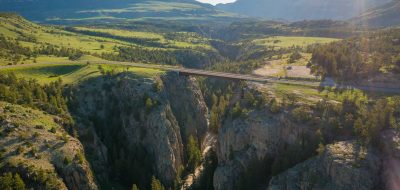Grizzly Bear Kills Hiker in Yellowstone National Park

A grizzly bear is shown in this undated photo. A grizzly bear killed a man hiking in Yellowstone National Park on July 6, 2011. (Credit: Getty Images)
A couple’s hike off South Rim Drive, south of Canyon Village and east of the park’s Grand Loop Road, Wednesday (July 6) morning, turned tragic when they surprised a grizzly bear sow and her cubs. Brian Matayoshi, 57, of Torrance, California, was hiking with his wife, Marylyn, on the Wapiti Lake Trail when they encountered the bears as the couple emerged from a forested area into an open meadow.
The hikers first spotted a bear about 100 yards away and began walking in the other direction, but when they turned to look back they saw the female grizzly charging at them down the trail, according to an account issued by park officials.
The couple began running, but the bear caught up to them and mauled the husband, then approached the wife, who had fallen to the ground nearby.
“The bear bit her daypack, lifting her from the ground and then dropping her,” the park statement said, but the woman remained still and the grizzly lumbered off.
Yellowstone and surrounding areas are home at least 600 grizzlies. Once rare to behold, grizzlies have become an almost routine cause of curious tourists lining up at Yellowstone’s roadsides at the height of summer season.
These tourists have been flooding into Yellowstone in record numbers: 3.6 million last year, up 10 percent from 2009’s 3.3 million, also a record.
It was the park’s first fatal grizzly mauling since 1986, but the third in the Yellowstone region in just over a year amid ever-growing numbers of grizzlies and tourists roaming the same wild landscape of scalding-hot geysers and sweeping mountain vistas.
Officials also issued recommendations for visitors to stay safe from backcountry bears:
- Stay on designated trails
- Hike in groups of three or more
- Make noise in places where a grizzly could be lurking
Bear spray—pressurized hot-pepper residue in a can—can be effective in stopping aggressive bears, they said.
Bears in Canada

Grizzly bears have a distinctive muscular shoulder hump, and the claws on the front paws are large, strong and slightly curved. (Credit: edu.pe.ca)
Canada is home to approximately 380,000 black bears and 26,000 grizzly bears, half of whom are found in British Columbia, according to the Nature Conservacy of Canada.
Avoid Bear Attacks
To avoid unwanted encounters with bears adhere to the following precautions:
- Obey all park regulations, stay on designated trails, and comply with posted warnings
- Solo hiking is not advised; the risk of an attack is reduced hiking in a group
- Always keep children nearby and in sight
- If possible, keep pets at home. Free-running pets can anger a bear and provoke an attack
- Make warning noises and loud sounds, e.g., attach bells to hiking boots
- Pepper/bear spray has been effective in deterring some bear attacks; however, do not rely on it as a substitute for safe practices in bear country
Bear Facts
- Bears are as fast as racehorses, on the flats, uphill, or downhill
- Bears aggressively defend their food
- All female bears defend their cubs; if a female with cubs is surprised at close range or is separated from her cubs, she may attack
- Bears are strong swimmers
- Bears have good eyesight and hearing, and an acute sense of smell
- All black bears and young grizzlies are agile tree climbers; mature grizzlies are poor climbers but they have a reach up to 13 feet
- All bears will defend a personal space; the extent of this space will vary with each bear and each situation; intrusion into this space is considered a threat and may provoke an attack
Know Your Bears

Black bears are North America's most familiar and common bears. They typically live in forests and are excellent tree climbers, but are also found in mountains and swamps. Despite their name, black bears can be blue-gray or blue-black, brown, cinnamon, or even (very rarely) white. be blue-gray or blue-black, brown, cinnamon, or even (very rarely) white. (Credit: canoe.ca)
Are you able to tell the difference between a black bear and a grizzly bear? Color is a poor indicator of bear species as both species can range in color from blond to black.
Some unique grizzly features include a pronounced shoulder hump, silver or light-tipped guard hairs on their head, and ears that appear smaller and are rounded.
Grizzly Bear (Ursus arctos horribilis Ord)
Color: Range in color from black to light blonde, mostly medium to dark brown in color; the long hair usually has a lighter tip, hence the grizzled look
Height: Approximately 3½ feet at shoulder; 6-7 feet when erect
Weight: Average 350-500 pounds; larger grizzlies can reach 800 pounds
Shape: Distinct shoulder hump
Face: Depression between the eyes and end of nose; short, round ears
Claws: Very long (2-4 inches)
Habitat: Prefers semi-open spaces; high country in late summer and early fall; valley bottoms late fall and spring
Black Bear (Ursus americanus Pallas)
Color: Range in color from black to light blonde, often with a lighter patch on the chest or at the throat; reddish-colored bears are common in the west
Height: Approximately 2½-3 feet at shoulder; about 5 feet when erect
Weight: Average 110-300 pounds; larger males can reach 600 pounds
Shape: No shoulder hump like the grizzly
Face: A straight line runs between the forehead and end of nose; roundish pointed ears
Claws: Shorter (about 1½ inches)
Habitat: Prefers forested areas with low-growing plants and berry-producing shrubs, small forest openings, streams, and lake edges
What to do if a Bear Attacks
Every encounter is unique and the following are offered as guidelines only to deal with an unpredictable animal and potentially complex situation.
Your response depends on the species and whether the bear is being defensive or offensive.
Bears sometimes bluff their way out of a confrontation by charging then turning away at the last moment. Generally, the response is to do nothing to threaten or further arouse the bear. Remain calm and avoid sudden movements.
Give the bear plenty of room, allowing it to continue its activities undisturbed. Remember that a standing bear is not always a sign of aggression. Many times, bears will stand to get a better view.
While fighting back usually increases the intensity of an attack, it may cause the bear to leave.
Note: Also posted on Bears and Bear Safety: Are You Bear Aware?
Worth Pondering…
When a pine needle falls in the forest, the eagle sees it; the deer hears it, and the bear smells it.
—old First Nations saying
You May Also Like
- Georgia: New State Park Opens
- How to Locate a Dump Station?
- Colorado: Explore Your Parks
- Michigan State Park Passport Program Reviewed
- Jayco Dealers Honored
If you enjoy these articles and want to read more on RV travels and lifestyle, visit my website: Vogel Talks RVing.







Julie
When bear viewing in Alaska our guide carried marine flares rather than bear spray or a gun. The bears do not like the noise or the intense light of the flare.
The advice given in the article is spot on. Our guide had us bunch up (looked like a larger mass) when the bears showed too much interest in us. Also, as we walked, he clapped his hands and spoke loudly. The biggest thing is do make sure the bear knows you are there and you do not startle them.
A bear stands so it can see better not as a sign of aggression. A charging bear is trying to scare you off. Most usually a sow (if she perceives a threat to cubs) or a cub (trying it out). Never, ever run. You cannot outrun a bear. Using the flare will stop the charge. If all else fails, lie down, fetal position, protect head and LAY STILL. The bear will usually lose interest.
Mike
There is danger in over thinking a situation
RIck
I believe that loaded guns ARE allowed in all National Parks as of 2010.
Glen
For those who think a gun is the answer, please think again. How do feel about killing a mother grizzly and orphaning the cubs (who will likely be “put down” as a result)? I’m not saying that the grizz should live and you should die, but understand that even if you are good with a gun, you will have a better chance of protecting yourself with bear spray than a gun. With a gun, you have to be calm, and your aim has to be right on, or you may just make the bear more angry. With pepper spray, you just have to be close, and it will likely stop the bear. Besides that, guns are not allowed in places such as Yellowstone.
Everyone, please take the time to become “bear aware” and equip yourself properly (spray, not gun) before heading out into the bush.
Kirk Singer
This is really not what happened. The people were hiking in a closed area and approached the female bear with two cubs. The bear perceived a danger to her cubs and acted acordingly. As the bear did nothing wrong, no action was taken against her
jack
bear rushes me and mine and gets dangerously close, he’s gonna get a bullet in the mouth.
Becky Blanton
Excellent article this. Best I’ve ever read on the topic! I am/was an avid hiker. For decades I spent every weekend and all summer hiking around the country. I followed all these tips (bear bells, singing and talking in densely wooded areas to alert a bear we were there etc) and still encountered a mother grizzly and her two cubs while hiking in Canada. I’ve also been treed and stalked by black bear hiking in the Smokey Mountains of Tennessee.
The one tip that wasn’t mentioned was one the rangers told us when we received our hiking permit – to always be scanning the area for trees you can climb, rocks you can climb, deep water you can go into etc. if you do see a bear. It’s like being aware of an escape route when driving, or knowing where to go in case of a fire. When being stalked by black bear (followed at a distance with no aggression-usually for food smells in backpack) my friend and I took a detour and headed for a secure shelter along the Appalachian Trail and stayed there for the night rather than in the tent we’d planned to use.
Look for trees with low lying limbs you can reach, or rocky walls or boulders you can scramble up. Even if the bear does climb up after you, as one did with me, you’re in a better position to fight it (as I did) by breaking off branches and bark and poking DOWN at it rather than facing it on level ground. They must hang on with at least one front paw to stay in the tree. It’s tiring on them and eventually they do back down and climb down when they realize you’re going to resist. In Canada I climbed a dead Lodgepole pine-and waited two hours for the bear to leave, which she did. The black bear in the other instance did too. The point is, always have an escapee route or be planning one. It helps you not freak out and keeps your adrenaline focused so you can act rather than react.
Michelle Mendoza
Thanks very much for posting this very informative article. I had no idea that Canada had that many bears, especially in B.C. Do you know if bear spray is 100% effective or just most of the time?